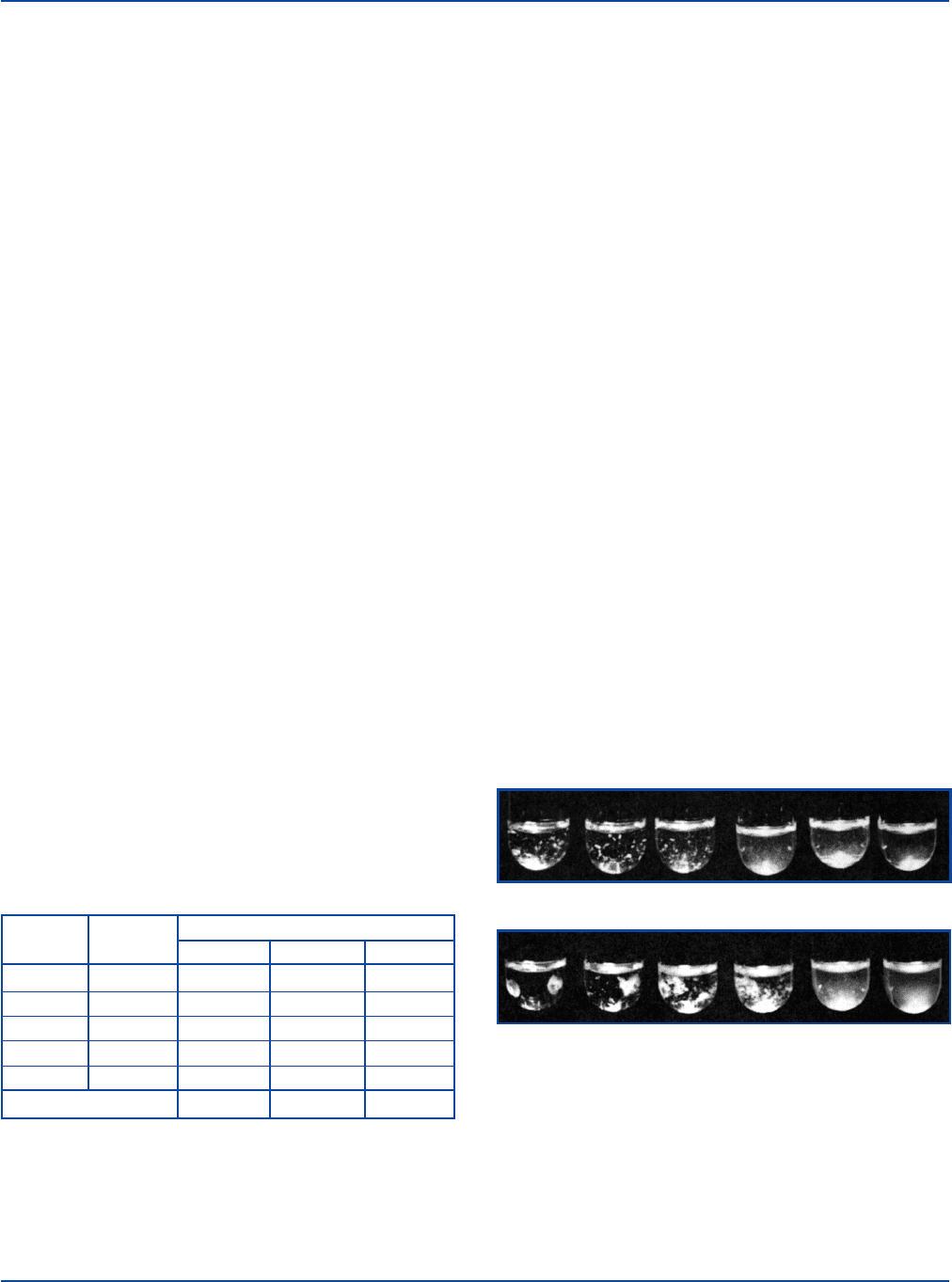BD Diagnostic Systems (publ.). Difco Manual (Manual of Microbiological Culture)
Подождите немного. Документ загружается.


800 The Difco Manual
VDRL Antigen & VDRL Test Control Serum Set Section V
Results - Qualitative Slide Test
1. Read and record results as follows:
Reactive (R) - Medium to large clumps
Weakly reactive (WR) - Small clumps
Nonreactive (N) - No clumping or very slight roughness
2. Verify that the control sera results are as expected. If reactions are
not as expected, the test is invalid and results cannot be reported.
3. Perform a quantitative test on all serum specimens that produce
Reactive, Weakly Reactive or “rough” Nonreactive results, since
prozone reactions are encountered occasionally.
VDRL Quantitative Test on Serum
1. To quantitate serum samples to an endpoint titer, prepare serum
dilutions on the slide at 1:1, 1:2, 1:4 and 1:8, as follows.
2. Dispense 50 µl of 0.9% saline in circles 2-4. Do not spread the saline.
3. Dispense 50 µl of serum in circles 1 and 2.
4. Mix the saline and the serum in circle 2 by drawing the mixture up
and down in the pipette 8 times. Avoid forming bubbles.
5. Transfer 50 µl from circle 2 (1:2) to circle 3 (1:4) and mix.
6. Transfer 50 µl from circle 3 (1:4) to circle 4 (1:8), mix, and then
discard 50 µl from circle 4.
7. Gently resuspend the antigen suspension.
8. Holding the antigen suspension dispensing needle and syringe in a
vertical position, dispense several drops to clear the needle of air.
Then add exactly 1 free-falling drop (17 µl) of antigen suspension
to each circle.
9. Place the slide on the mechanical rotator. Rotate the slide for
4 minutes at 180 ±2 rpm. When performing the test in a dry climate,
place the slides under a moist, humidifying cover during rotation
to prevent excessive evaporation.
10. Immediately after rotation, read the test results microscopically
using a 10X ocular and a 10X objective.
11. If the highest dilution tested (1:8) is reactive, prepare a 1:8 dilution
of the test specimen by adding 0.1 ml of serum to 0.7 ml of 0.9%
saline. Mix thoroughly. Retest as in steps 1-10, above.
Results - Quantitative Test
Report the titer as the highest dilution that produces a Reactive (not
Weakly Reactive) result.
Table 1. Sample quantitative VDRL Test results.
If reactive results are obtained through dilution 1:32, prepare further
twofold serial dilutions in 0.9% saline (1:64, 1:128 and 1:256) and
retest using the quantitative test procedure.
Interpretation
1. The results of the serum VDRL Test must be confirmed by a
treponemal test.
2. The diagnosis of syphilis depends on the results of the VDRL test,
the treponemal confirmatory test, clinical signs and symptoms,
and risk factors.
3. A reactive VDRL Test may indicate past or present infection with a
pathogenic treponeme. However, it may be a false-positive reaction.
A false positive is determined if the confirmatory treponemal test
is negative.
4. A nonreactive VDRL Test with clinical evidence of syphilis may
indicate early, primary syphilis, a prozone reaction in secondary
syphilis, or late syphilis.
5. A nonreactive VDRL Test with no clinical evidence of syphilis
indicates no current infection or an effectively treated infection.
6. A quantitative VDRL Test detects changes in reagin titer. Therefore
a serum specimen showing a fourfold increase in titer on a repeat
specimen may indicate an infection, a reinfection or a treatment
failure. Likewise, a fourfold decrease during treatment indicates
adequate syphilis therapy.
VDRL Test on Spinal Fluid
Consult an appropriate reference for the procedure to use when testing
spinal fluids by the VDRL Test.
1
Limitations of the Procedure
1. A prozone reaction may occur in which reactivity with undiluted
serum is inhibited. The prozone phenomenon often gives Weakly
Reactive or “rough” Nonreactive results in the qualitative test.
Specimens with such results must be quantitatively tested.
2. Biological false-positive reactions can occur with nontreponemal
tests in persons who abuse drugs, have diseases such as lupus
erythematosus, mononucleosis, malaria, leprosy or viral pneumonia,
or who have recently been immunized.
1
3. During manufacturing, VDRL Antigen with VDRL Buffered Saline
is tested only with serum. To modify the serum test products and
procedures for testing CSF, consult the appropriate reference.
1
The
user is responsible for modifying the products and procedures and
for the required quality control standards according to this manual.
4. Prolonged exposure of reagents to temperatures other than those
specified is detrimental to the products.
5. VDRL Buffered Saline showing turbidity or mold growth should
be discarded.
6. If the temperature of the testing area, specimens or reagents is less
than 23°C, test reactivity is decreased. If the temperature is greater
than 29°C, test reactivity is increased.
1
7. Test results are unpredictable when testing hemolyzed, contaminated
or extremely turbid serum specimens.
8. For correct test results, adhere strictly to the correct speed and
length of time for rotating the specimens and antigen.
SERUM DILUTIONS REPORT
Undiluted
(1:1) 1:2 1:4 1:8 1:16 1:32
R W N N N N Reactive,
undiluted
R R W N N N Reactive,
1:2 dilution
R R R W N N Reactive,
1:4 dilution
W W R R W N Reactive,
1:8 dilution
N W R R R N Reactive,
(rough) 1:16 dilution
W NNNN N Weakly
reactive,
undiluted

The Difco Manual 801
Section V Vibrio Cholerae Antisera
References
1. Larsen, S. A., E. F. Hunter, and S. J. Kraus. 1990. A manual of
tests for syphilis. American Public Health Association.
2. Creighton, E. T. 1990. Dark field microscopy for the detection
and identification of Treponema pallidum, p. 49-61. In S. A. Larsen,
E. F. Hunter, and S. J. Kraus (ed.), Manual of tests for syphilis,
8th ed. American Public Health Association, Washington, D.C.
3. Janda, W. M. (ed.). 1992. Immunology, p. 9.7.1-9.7.20. In H. D.
Isenberg (ed.), Clinical microbiology procedures handbook, vol.
2. American Society for Microbiology, Washington, D.C.
4. Norris, S. J., and S. A. Larsen. 1995. Treponema and other host-
associated spirochetes, p. 636-651. In P. R. Murray, E. J. Baron,
M. A. Pfaller, F. C. Tenover, and R. H. Yolken (ed.), Manual of
clinical microbiology, 6th ed. American Society for Microbiology,
Washington, D.C.
5. Matthews, H. M., T. K. Yang, and H. M. Jenkin. 1979. Unique
lipid composition of Treponema pallidum (Nichols virulent strain).
Infect. Immun. 24:713-719.
6. Harris, A., A. A. Rosenberg, and L. M. Riedel. 1946.
A microflocculation test for syphilis using cardiolipin antigen.
J. Ven. Dis. Infor. 27:169-174.
7. Pangborn, M. C. 1941. A new serologically active phospholipid
from beef heart. Proc. Soc. Exp. Biol. and Med. 48:484-486.
8. Pangborn, M. C. 1944. Acid cardiolipin and an improved method
for the preparation of cardiolipin from beef heart. J. Biol. Chem.
153:343-348.
9. Pangborn, M. C. 1945. A simplified preparation of cardiolipin,
with a note on purification of lecithin for serologic use. J. Biol.
Chem. 161:71-82.
10. U. S. Department of Health and Human Services. 1988.
Biosafety in microbiological and biomedical laboratories, 2nd ed.
U. S. Department of Health and Human Services publication no.
88-8395. U. S. Government Printing Office, Washington, D.C.
11. Centers for Disease Control. 1988. Update: universal precautions
for prevention of transmission of human immunodeficiency virus,
hepatitis B virus, and other bloodborne pathogens in health-care
settings. Morbidity and Mortality Weekly Reports 37:377-382,
387-388.
12. Occupational Safety and Health Administration, U.S.
Department of Labor. 1991. 29 CFR, part 1910. Occupational
exposure to bloodborne pathogens, final rule. Federal Register
56:64175-64182.
13. Miller, J. M., and H. T. Holmes. 1995. Specimen collection, trans-
port and storage. In P. R. Murray, E. J. Baron, M. A. Pfaller, F. C.
Tenover, and R. H. Yolken (ed.), Manual of clinical microbiology,
6th ed. American Society for Microbiology, Washington, D.C.
Packaging
VDRL Antigen w/Buffered Saline 5 ml 0388-56
10 x 0.5 ml 0388-49
VDRL Test Control Serum Set 1 set 3520-32
Contains:
Nontreponemal Antigen
Reactive Serum 3 ml
VDRL Weakly Reactive Serum 3 ml
Nontreponemal Antigen
Nonreactive Serum 3 ml
Aliquant Vials 3 vials
Bacto
®
Vibrio Cholerae Antisera
Vibrio Cholerae Antiserum Inaba
.
Vibrio Cholerae Antiserum
Ogawa
.
Vibrio Cholerae Antiserum Poly
User Quality Control
Identity Specifications
Vibrio Cholerae Antiserum Inaba
Vibrio Cholerae Antiserum Ogawa
Vibrio Cholerae Antiserum Poly
Lyophilized appearance: Light gold to amber button to
powdered cake
Rehydrated appearance: Light gold to amber, clear liquid
Performance Response
Rehydrate Vibrio Cholerae Antisera per label directions.
Perform the slide agglutination test using appropriate known
cultures of Vibrio cholerae as positive and negative controls.
Intended Use
Bacto Vibrio Cholerae Antisera are used for serotyping Vibrio cholerae
in slide agglutination tests.
Summary and Explanation
V. cholerae are facultative anaerobes that in microscopic morphology
are gram-negative, curved or straight bacilli. The microorganisms
either require sodium chloride or grow best in its presence. Various
media designed to select and cultivate the growth of this microorganism
are used in the clinical laboratory, the food industry and environmental
testing.
V. cholerae is the causative agent of a secretory diarrhea known as
cholera. Two biotypes, El Tor and Classical, are associated with
human disease.
1
These two biotypes cannot be differentiated sero-
logically. The spread of the disease is primarily through contaminated

802 The Difco Manual
Vibrio Cholerae Antisera Section V
water and by the fecal-oral route. Infections with V. cholerae may be
asymptomatic, mild or severe. If not treated, patients with severe
cholera may die within five hours from massive fluid and electrolyte
loss.
1
Because Vibrio species are natural inhabitants of aquatic
environments, food products such as uncooked or incorrectly handled
seafood can spread infection.
Gastrointestinal symptoms of cholera include “rice water stools”
caused by a potent enterotoxin. The primary human specimen is feces.
Seafood products are frequently tested as vehicles of human infection.
In 1935, Gardner and Ventkatraman
2
published a classification scheme
for Vibrio cholerae. V. cholerae isolated from cholera patients was
classified as O1. All other strains were designated non-O1. Non-O1
V. cholerae causes both gastroenteritis and systemic infections. Some
strains produce cholera enterotoxin. Non-O1 V. cholerae has been
isolated from blood, wounds, ears, sputum, cerebro-spinal fluid and urine.
3,4
V. cholerae of the O1 serogroup are divided into the serotypes Ogawa,
Inaba and Hikojima.
5,6
The antigenic factors are:
SEROTYPE O ANTIGEN FACTORS
Ogawa AB
Inaba AC
Hikojima ABC
Cholera can be diagnosed retrospectively. A fourfold rise in titer
between acute-phase serum and that collected 10-14 days later is
considered diagnostic.
7
Principles of the Procedure
Identification of V. cholerae includes the isolation of the microorganism
as well as biochemical identification and serological confirmation.
Serological confirmation requires that the microorganism (antigen)
react with its corresponding antibody. This in vitro reaction produces
macroscopic clumping called agglutination. The desired homologous
reaction is rapid, does not dissociate (high avidity) and binds (high
affinity).
Because a microorganism may agglutinate with an antibody produced
in response to another species, heterologous reactions are possible.
These are characterized as weak in strength or slow in formation. Such
unexpected and unpredictable reactions may lead to some confusion in
serological identification. A positive homologous agglutination reaction
should support the morphological and biochemical identification of
the microorganism.
Homologous reactions occur rapidly and are strong. Heterologous
reactions form slowly and are weak.
Reagents
Vibrio Cholerae Antisera are lyophilized, polyclonal rabbit Vibrio
cholerae O1 antisera containing approximately 0.04%Thimerosal as
a preservative. Vibrio Cholerae Antisera Inaba and Ogawa are
monospecific absorbed antisera.
Vibrio Cholerae Antisera possess the following antibodies:
ANTISERUM O ANTIBODIES
Vibrio Cholerae Antiserum Inaba C
Vibrio Cholerae Antiserum Ogawa B
Vibrio Cholerae Antiserum Poly ABC
Each vial of Vibrio Cholerae Antiserum contains sufficient reagent for
20 slide tests.
Precautions
1. For In Vitro Diagnostic Use.
2. Vibrio Cholerae Antiserum Inaba
Vibrio Cholerae Antiserum Ogawa
Vibrio Cholerae Antiserum Poly
The Packaging of This Product Contains Dry Natural Rubber.
3. Follow proper established laboratory procedure in handling and
disposing of infectious materials.
Storage
Store lyophilized and rehydrated Vibrio Cholerae Antisera at 2-8°C.
Expiration Date
The expiration date applies to product in its intact container when stored
as directed. Do not use a product if it fails to meet specifications for
identity and performance.
Procedure
Materials Provided
Vibrio Cholerae Antiserum Inaba
Vibrio Cholerae Antiserum Ogawa
Vibrio Cholerae Antiserum Poly
Materials Required But Not Provided
Agglutination slides
Applicator sticks
Sterile 0.85% NaCl solution
Reagent Preparation
Equilibrate all materials to room temperature before performing the
tests. Ensure that all glassware and pipettes are clean and free of
residues such as detergent.
Vibrio Cholerae Antisera: To rehydrate, add 3 ml sterile 0.85% NaCl
solution and rotate gently to completely dissolve the contents. The
rehydrated antiserum is considered a 1:2 working dilution.
Specimen Collection and Preparation
V. cholerae can be recovered from clinical specimens on selective
media such as thiosulfate-citrate-bile salts-sucrose (TCBS) agar. For
specific recommendations, consult appropriate references.
1,8,9
V. cholerae can be recovered from various types of foods, particularly
seafood. Samples are processed to prevent overgrowth of competing
microorganisms and selective media are used to enhance the growth of
the microorganism. Some isolation media have been specifically
developed for the food industry. Consult appropriate references for
recommended procedures for isolating V. cholerae from food.
10,11
The isolate for serological testing should be subcultured from
selective media to a nonselective agar such as Nutrient Agar. Consult
standard protocols in appropriate references for the type of specimen
and the appropriate medium.
1, 8-11
Having followed an established protocol, determine that a pure culture
of the microorganism has been obtained and that biochemical test
reactions are consistent with the identification of the organism as
V. cholerae. After these criteria are met, serological identification can
be performed.

The Difco Manual 803
Section V Vibrio Cholerae Antisera
Testing the isolate for autoagglutination:
1. From the test culture, transfer a loopful of growth to a drop (35 µl)
of sterile 0.85% NaCl solution on a clean slide and emulsify the
organism.
2. Rotate the slide for one minute, then observe for agglutination.
3. If autoagglutination occurs, the culture is rough and cannot be
tested. Subculture to a nonselective medium, incubate and test the
organism again as described in steps 1 and 2.
If no agglutination occurs, proceed with testing the organism as
described below.
Test Procedure
Use Vibrio Cholerae Antiserum Poly to screen possible V. cholerae
isolates. Continue testing with Vibrio Cholerae Antisera Inaba and
Ogawa. Include known positive and negative control cultures.
1. Vibrio Cholerae Antiserum: Dispense a drop of the antiserum to
be tested on an agglutination slide.
2. Test organism: Transfer a loopful of growth to the drop of antiserum
and mix thoroughly.
3. Rotate the slide for one minute and read for agglutination.
Results
1. Read and record results as follows:
4+ 100% agglutination; background is clear to slightly hazy.
3+ 75% agglutination; background is slightly cloudy.
2+ 50% agglutination; background is moderately cloudy.
1+ 25% agglutination; background is cloudy.
– No agglutination.
1. Positive control: Should produce 3+ or greater agglutination.
2. Negative control: Should show no agglutination.
3. Test isolates: 3+ or greater agglutination within one minute is a
positive result.
Interpretation
Agglutination of the monospecific antiserum, when used, provides
preliminary presumptive identification of the serotype.
0.85% NACL
SOLUTION
CONTROL POLY OGAWA INABA INTERPRETATION
– – Not V. cholerae
– + Presumptively V. cholerae
–++–V. cholerae serotype Ogawa
–+–+V. cholerae serotype Inaba
– +++V. cholerae serotype Hikojima
+ Any Any Any Autoagglutination.
Unsuitable test culture.
+ agglutination
– no agglutination
1. Positive agglutination using Vibrio Cholerae Antiserum Poly with
typical biochemical test results gives presumptive identification of
V. cholerae O1.
2. Cultures with positive agglutination in Vibrio Cholerae Antiserum
Poly may be serotyped using the Vibrio Cholerae Antiserum Ogawa
and Vibrio Cholerae Antiserum Inaba. Positive agglutination in
both antisera is rare and, when it occurs, is usually interpreted as
identifying V. cholerae serotype Hikojima.
6
V. cholerae serotype
Hikojima is a rare serotype and should be sent to a reference
laboratory for further study.
3. Positive agglutination will be immediate and strong. The strongest
and most rapid reaction should be used to identify the serotype.
V. cholerae O1 strains frequently cross-react slowly or weakly in
monospecific antiserum for the other serotype.
4. Isolates that weakly or slowly agglutinate with Vibrio Cholerae
Antiserum Poly and not with Vibrio Cholerae Antiserum Inaba or
Vibrio Cholerae Antiserum Ogawa are usually considered
V. cholerae non-O1. The isolate may be sent to a reference laboratory
for further study.
Limitations of the Procedure
1. Correct interpretation of serological reactions depends on culture
purity as well as morphological characteristics and biochemical
reactions that are consistent with identification of the microorganism
as V. cholerae.
2. Serological methods alone cannot identify the isolate as V. cholerae.
3. Excessive heat from external sources (hot bacteriological loop,
burner flame, light source, etc.) may prevent a smooth suspension
of the microorganism or cause evaporation or precipitation of the
test mixture. False-positive reactions may occur.
4. Rough culture isolates do occur and will agglutinate spontaneously,
causing agglutination of the negative control reaction (autoagglu-
tination). Smooth colonies must be selected and tested in serological
procedures.
5. Vibrio Cholerae Antisera have been tested using undiluted cultures
taken from agar media. These antisera have not been tested using
antigen suspensions in NaCl solution or other diluents. If the user
applies variations to the recommended procedure, each lot of
antiserum must be tested with known control cultures to verify
expected reactions under the modified procedure.
6. Prolonged exposure of reagents to temperatures other than those
specified is detrimental to the products.
7. Rehydrated Vibrio Cholerae Antiserum that is cloudy or has a
precipitate at any time during its use should be discarded.
References
1. McLaughlin, J. C. 1995. Vibrio, p. 465-476. In P. R. Murray, E. J.
Baron, M. A. Pfaller, F. C. Tenover, and R. H. Yolken (ed.),
Manual of clinical microbiology, 6th ed. American Society for
Microbiology, Washington, D.C.
2. Gardner, A. D., and K. V. Venkatraman. 1935. The antigens of
the cholera group of vibrios. J. Hyg. 35:262-282.
3. Florman, A. L., A. H. Cushing, T. Byers, and S. Popejoy. 1990.
Vibrio cholerae bacteremia in a 22-month-old New Mexican child.
Pediatr. Infect. Dis. J. 9:63-65. (Letter).
4. Morris, J. G., Jr. 1990. Non-O group 1 Vibrio cholerae: a look at
the epidemiology of an occasional pathogen. Epidemiol. Rev.
12:179-191.
5. Nobechi, K. 1923. Contributions to the knowledge of V. cholerae.
3. Immunological studies upon the types of V. cholerae. Sci. Repr.
Govt. Inst. Infect. Dis. 2:43-87.

804 The Difco Manual
Widal Antigen Set Section V
6. Kelly, M. T., F. W. Hickman-Brenner, and J. J. Farmer III.
1991. Vibrio, p. 384-395. In A. Balows, W. J. Hausler, K. L.
Herrmann, H. D. Isenberg, and H. J. Shadomy (ed.), Manual of
clinical microbiology, 5th ed. American Society for Microbiology,
Washington, D.C.
7. Smith, H. L. 1981. Vibrio Infections, p. 715-722. In A. Balows,
and W. J. Hausler (ed.), Bacterial, mycotic and parasitic infections,
6th ed. American Public Health Association, Washington, D.C.
8. Pezzlo, M. 1992. Aerobic bacteriology, p. 1.0.1.-1.20.47. In H. D.
Isenberg (ed.). Clinical microbiology procedures handbook, vol.
1. American Society for Microbiology, Washington, D.C.
9. Baron, E. J., L. R. Peterson, and S. M. Finegold. 1994. Bailey &
Scott’s diagnostic microbiology, 9th ed. Mosby-Year Book, Inc.,
St. Louis, MO.
10. Kaysner, C. A., M. L. Tamplin, and R. M. Twedt. 1992. Vibrio,
p. 451-473. In C. Vanderzant and D. F. Splittstoesser, (ed.), Com-
pendium of methods for the microbiological examination of foods,
3rd ed. American Public Health Association, Washington, D.C.
11. Elliot, E. L., C. A. Kaysner, L. Jackson, and M. L. Tamplin.
1995. Vibrio cholerae, V. parahaemolyticus, V. vulnificus, and
other Vibrio sp., p. 9.01-9.27. In Food and Drug Administration,
Bacteriological analytical manual, 8th ed. AOAC International,
Gaithersburg, MD.
Packaging
Vibrio Cholera Antiserum Inaba 3 ml 2430-47
Vibrio Cholera Antiserum Ogawa 3 ml 2431-47
Vibrio Cholera Antiserum Poly 3 ml 2432-47
Bacto
®
Widal Antigen Set
C
ONTAINS
: Salmonella O Antigen
.
Salmonella H Antigens
Salmonella Vi Antigen
.
Febrile Positive Control Polyvalent
Febrile Negative Control
A
LSO
A
VAILABLE
: Salmonella O Antigens
.
Salmonella H Antigen
Intended Use
Bacto Widal Antigen Set, which contains four Salmonella antigens,
is used in detecting Salmonella antibodies by slide and tube aggluti-
nation tests.
Bacto Salmonella H, O and Vi Antigens, available individually, are
used in detecting Salmonella antibodies by slide and tube agglutina-
tion tests.
Summary and Explanation
Salmonellae represent many species of pathogenic microorganisms
that, upon invasion, produce a fever in their host. Consequently, they
are often called “Febrile Antigens”. Salmonella species cause a variety
of human diseases called salmonelloses. The range of disease is from
mild self-limiting gastroenteritis to a more severe form, possibly with
bacteremia or typhoid fever, which can be severe and life-threatening.
Severe disease and bacteremia are associated primarily with
S. Choleraesuis, S. Paratyphoid A and S. Typhi, while most of the other
2,300 or more strains are associated with gastroenteritis. The severity
of the diarrheal disease depends on the virulence of the strain and the
condition of the human host.
Salmonella is found in nature and occurs in the intestinal tract of many
animals, both wild and domestic. The microorganism can spread to
man from contact with the environment or from eating contaminated
meat or vegetable food products.
The genus Salmonella is in the family Enterobacteriaceae. Salmonellae
are facultatively anaerobic, gram-negative bacilli that typically are
oxidase negative, non-lactose fermenting, H
2
S positive and produce
gas. Serotypes of Salmonella are defined based on antigenic structure,
both somatic or cell wall (O) antigens and flagellar (H) antigens. The
antigenic formula lists the O antigen(s) followed by the H antigen(s).
In 1896, Widal introduced techniques for testing patient serum for
antibodies in cases of typhoid fever.
1
The Widal test was used diagnos-
tically in two ways. First, it was considered diagnostic when a single
high antibody titer occurred during the first week of illness. Further, it
was diagnostic if a greater than fourfold rise in titer existed in serum
samples taken 1 to 2 weeks apart.
2,3,4
The Widal test was developed to
include Salmonella Typhi and other species of Salmonella detected by
a variety of O and H antigens. S. Typhi and S. Paratyphi A and B are
the major pathogens in this group that can produce clinically distinct
systemic illness. In areas such as developing countries where typhoid
is highly endemic, the diagnostic value of the Widal test has been well
documented.
5,6,7
The Widal test for antibodies to the O antigens of
Salmonella serotypes most likely to cause typhoid fever (usually
S. Typhi and S. Paratyphi A and B) can be useful in helping diagnose
typhoid fever when other methods have failed.
8
Diagnosis of the cause of febrile disease cannot be based solely on the
analysis of serum samples for antibody response. Many factors may
affect measurable antibody levels. For example, the patient’s immune
response can be affected by age, immune status, general state of health
and previous immunizations. Patients with known typhoid fever have
developed diagnostic titers of antibodies that are low.
9,10
Also, patients
treated with antibiotics early in their disease may not develop a
significant titer rise.
2

The Difco Manual 805
Section V Widal Antigen Set
User Quality Control
Identity Specifications
Salmonella O Antigens
Salmonella H Antigens
Salmonella Vi Antigen
Appearance: Turquiose-blue-violet suspension.
Febrile Positive Control Polyvalent
Lyophilized Appearance: Light gold to amber, button to
powdered cake.
Rehydrated Appearance: Light gold to amber, clear liquid.
Febrile Negative Control
Lyophilized Appearance: Colorless to light gold, button to
powdered cake.
Rehydrated Appearance: Colorless to light gold, clear liquid.
Performance Response
Rehydrate Febrile Positive Control Polyvalent and Febrile
Negative Control per label directions. Perform the slide or
tube agglutination test using Salmonella O, H or Vi Antigens
and positive and negative controls diluted in the same
proportion as a patient serum.
A Salmonella Antigen is considered satisfactory if it does not
agglutinate with the negative control and gives a 2+ or greater
reaction at a 1:80 dilution with the positive control.
The various species of Salmonella contain multiple antigens that are
cross-reactive. This prevents using increased antibody levels, alone, to
identify infecting organisms by species or serotype. Other non-
typhoidal febrile illness or unrelated immunological disorders may
produce significant elevations of antibody titers.
2
Certain organisms may share cross-reacting antigens leading to the
production of heterologous antibodies. These heterologous antibodies
may react with one or more antigens in an antibody test procedure,
resulting in low-level antibody titers that may not, singly, suggest disease.
The rapid slide procedure is a screening test designed to detect agglu-
tinins. The macroscopic tube test
11
is a confirmatory procedure
designed to quantitate agglutinin compositions. Any positive results
obtained in the screening (slide) test of specimens must be confirmed
by a tube test.
The rapid slide test is the most widely used procedure employing the
Widal antigens because of the simplicity with which the results may be
reported. Negative slide test reactions can usually be reported as such
if all five serum dilutions have been used. Although the slide test is not
quantitative, running the series of dilutions is necessary to detect
agglutinins that might be overlooked with a “prozone phenomenon”. This
often occurs in serum containing a high titer of typhoid agglutinins where
higher concentrations of the serum may yield negative results but a
dilution of the serum is positive.
Principles of The Procedure
Agglutination tests involving the use of Salmonella antigens determine
the presence of antibodies that react with the test antigen. The serological
procedure involves serially diluting the patient serum and then adding
a standard volume of antigen. The end point of the test is the last
dilution of the serum that shows a specific amount of agglutination.
The end point, reported as a dilution of the serum, is called the patient’s
antibody “titer.”
Reagents
Antigens
1. Salmonella Antigens are ready-to-use suspensions of the
Salmonella organisms listed below. Salmonella O Antigens
contain 20% glycerin.
Widal Antigen Set contents:
Salmonella O Antigen Group D - Salmonella Typhi O901,
factors 9,12 (selected strain)
Salmonella H Antigen a - Salmonella Paratyphi A.
Salmonella H Antigen b - Salmonella Paratyphi B.
Salmonella H Antigen d - Salmonella Typhi H901.
Salmonella O and H Antigens, available individually, are
prepared from selected strains containing the following group-
specific antigens:
Salmonella H Antigen c - flagellar antigen c
Salmonella O Antigen Group A - factors 1, 2, 12
Salmonella O Antigen Group B - factors 1, 4, 5, 12
Salmonella O Antigen Group C - factors 6, 7, (8), 20
Salmonella Vi Antigen
When used as described, each vial contains sufficient reagent for
20 slide tests or 25 tube tests.
2. Concentration of Antigen: Salmonella O, H and Vi Antigens are
used undiluted for the slide test and diluted 1:20 for the tube test.
3. Antigen Density: Salmonella O, H and Vi Antigens are adjusted to
a density approximating 20 times a McFarland Barium Sulfate
Standard No. 3 (1.8 x 10
10
organisms per ml).
Because antigen density may vary, it is adjusted for optimum
performance when standardized with hyperimmune sera obtained
from laboratory animals.
Variation in color intensity of the antigen is normal and will not
affect the outcome of the test.
4. Salmonella Antigens contain the following preservatives:
Salmonella O Antigens: 0.5% phenol, and approximately 0.002%
crystal violet and 0.005% brilliant green.
Salmonella H Antigens: 0.5% formaldehyde, and approximately
0.002% crystal violet and 0.005% brilliant green.
Salmonella Vi Antigen: 0.5% phenol, and approximately 0.002%
crystal violet and 0.005% brilliant green.
Antisera:
1. Febrile Positive Control Polyvalent is lyophilized, polyclonal,
polyvalent goat antisera containing approximately 0.04% Thime-
rosal as a preservative. This reagent contains antibodies at a titer
of 1:80 or greater for the Salmonella O and H Antigens in the
Widal Antigen Set.
Each vial of Febrile Positive Control Polyvalent contains sufficient
reagent for 32 slide tests or 50 tube tests using the four antigens
contained in the Widal Antigen Set. When using the Salmonella O,
H and Vi Antigens separately, there is sufficient reagent for 20 slide
or 25 tube tests.

806 The Difco Manual
Widal Antigen Set Section V
2. Febrile Negative Control is a lyophilized, standard protein solution
containing approximately 0.02% Thimerosal as a preservative.
Each vial of Febrile Negative Control contains sufficient reagent
for 32 slide tests when using the four antigens contained in the Widal
Antigen Set. When using the Salmonella O, H and Vi Antigens
separately, there is sufficient reagent for 20 slide tests.
Precautions
1. For In Vitro Diagnostic Use.
2. Observe universal blood and body fluid precautions in the handling
and disposing of specimens.
12,13
3. Salmonella H Antigen a
Salmonella H Antigen b
Salmonella H Antigen c
Salmonella H Antigen d
POSSIBLE RISK OF IRREVERSIBLE EFFECTS. (US) Avoid
contact with skin and eyes. Do not breathe mist. Wear suitable
protective clothing. Keep container tightly closed. TARGET
ORGAN(S): Eyes, Kidneys, Lungs, Skin.
FIRST AID: In case of contact with eyes, rinse immediately with
plenty of water and seek medical advice. After contact with skin,
wash immediately with plenty of water. If inhaled, remove to fresh
air. If not breathing, give artificial respiration. If breathing is diffi-
cult, give oxygen. Seek medical advice. If swallowed seek medical
advice immediately and show this container or label.
4. Follow proper established laboratory procedure in handling and
disposing of infectious materials.
5. Salmonella O, H and Vi Antigens are not intended for use in the
immunization of humans or animals.
Storage
Store Salmonella O, H and Vi Antigens at 2-8°C.
Store lyophilized and rehydrated Febrile Positive Control Polyvalent
at 2-8°C.
Store lyophilized and rehydrated Febrile Negative Control at 2-8°C.
Expiration Date
The expiration date applies to the product in its intact container when
stored as directed. Do not use a product if it fails to meet specifications
for identity and performance.
Procedure
Materials Provided
Widal Antigen Set:
Salmonella O Antigen Group D
Salmonella H Antigen Group a
Salmonella H Antigen Group b
Salmonella H Antigen Group d
Febrile Positive Control Polyvalent
Febrile Negative Control
Available separately:
Salmonella O Antigens
Salmonella H Antigens
Salmonella Vi Antigen
Febrile Positive Control Polyvalent
Febrile Negative Control
Droppers, 0.03 ml per drop (supplied)
Materials Required but not Provided
Slide test
Agglutination slides, 5 squares, 1” each
Applicator sticks
Sterile distilled or deionized water
Serological pipettes, 0.2 ml
Tube Test
Culture tubes 12 x 75 mm and rack
Waterbath, 50 ± 2°C
Serological pipettes, 1 ml and 5 ml
Sterile 0.85% NaCl solution
Reagent Preparation
Salmonella O, H and Vi Antigens are ready to use in the slide test.
Salmonella O and H antigens must be diluted 1:20 for the tube tests.
(See Test Procedure for preparation instructions).
Equilibrate all materials to room temperature before performing the
tests. Ensure that all glassware and pipettes are clean and free of
residues such as detergent.
Febrile Positive Control Polyvalent: To rehydrate, add 5 ml sterile
distilled or deionized water and rotate gently to completely dissolve
the contents.
Febrile Negative Control: To rehydrate, add 5 ml sterile distilled or
deionized water and rotate gently to completely dissolve the contents.
Specimen Collection and Preparation
Collect a blood specimen by aseptic venipuncture. Serum is required
for the test. Store serum specimens at room temperature for no longer
than 4 hours; for prolonged storage, keep at 2-8°C for up to 5 days or
maintain at or below -20°C. Serum specimens must be clear, free of
hemolysis and show no visible evidence of bacterial contamination (tur-
bidity, hemolysis or particulate matter). Refer to appropriate references
for more information on collection of specimens.
14,15
Serum specimens
must not be heated. Heat may inactivate or destroy certain antibodies.
Because changes in titer over a period of time are the best indicators of
active infection, and because the accuracy and precision of the tests
can be affected not only by test conditions but also by the subjectivity of
the person reading the endpoint, the following protocol is recommended.
A preliminary test using either the rapid slide test and/or the macro-
scopic tube test may be performed on the initial serum specimen and
reported to the physician at that time. An aliquot of the serum should
be transferred to a sterile test tube, sealed tightly, and kept in the freezer.
When the second serum is obtained, it should be run in parallel with
the original specimen. In this manner, the original serum will serve as
a control. Any difference in titer will be more credible, since the bias
associated with the performance of the test and determining the
endpoint will be reduced.
Test Procedure
Rapid Slide Test
Use the slide test only as a screening test. Confirm positive results with
the tube test.

The Difco Manual 807
2. Sterile 0.85% NaCl solution: Dispense 0.9 ml in the first tube of
each row and 0.5 ml in the remaining tubes.
3. Test serum: Using a 1 ml serological pipette, dispense 0.1 ml of
test serum in the first tube in the row and mix thoroughly. Transfer
0.5 ml from tube 1 to tube 2 and mix thoroughly. Similarly, con-
tinue transferring 0.5 ml through tube 7, discarding 0.5 ml from
tube 7 after mixing. Tube 8 is the antigen control tube and contains
only sterile 0.85% NaCl solution.
4. Positive control: Using a 1 ml serological pipette, dispense 0.1 ml
of Febrile Positive Control Polyvalent in the first tube in the row
and mix thoroughly. Transfer 0.5 ml from tube 1 to tube 2 and mix
thoroughly. Similarly, continue transferring 0.5 ml through tube 7,
discarding 0.5 ml from tube 7 after mixing. Tube 8 is the antigen
control tube and contains only sterile 0.85% NaCl solution.
5. Salmonella Antigen: Add 0.5 ml of the diluted antigen to all 8
tubes in each row and shake the rack to mix the suspensions.
6. The final dilutions in tubes 1-7 are 1:20, 1:40, 1:80, 1:160, 1:320,
1:640 and 1:1280, respectively.
7. H antigen tests: Incubate in a waterbath at 50 ± 2°C for 1 hour.
O antigen tests: Incubate in a waterbath at 50 ± 2°C for 17 ± 1 hours.
8. Remove from the waterbath. Avoid excessive shaking before
reading the reactions, either when the tubes are in the waterbath or
when removing them from the waterbath.
9. Read and record the results.
Results
1. Tube agglutination reactions detect antibodies to either somatic
(O) antigens or flagellar (H) antigens and these antibodies give
two different reactions. An O antigen and the corresponding antibody
give a coarse, compact agglutination which may be difficult to
disperse. An H antigen and its corresponding antibody give a loose,
flocculent agglutination. Do not vigorously shake tubes containing
H antigens. Characteristic O and H agglutination is shown in the
following diagrams.
Somatic “O” Agglutination
Flagellar “H” Agglutination
2. Read and record results as follows:
4+ 100% agglutination; background is clear to slightly hazy.
3+ 75% agglutination; background is slightly cloudy.
2+ 50% agglutination; background is moderately cloudy.
1+ 25% agglutination; background is cloudy.
– No agglutination.
3. Positive control: Should show 2+ or greater agglutination at the
1:80 dilution.
Section V Widal Antigen Set
1. Test serum: Using a 0.2 ml serological pipette, dispense 0.08, 0.04,
0.02, 0.01 and 0.005 ml of each test serum into a row of squares on
an agglutination slide.
2. Positive control: Using a 0.2 ml serological pipette, dispense 0.08,
0.04, 0.02, 0.01 and 0.005 ml of Febrile Positive Control Polyva-
lent into a row of squares on the agglutination slide.
3. Negative control: Using a 0.2 ml serological pipette, dispense 0.08,
0.04, 0.02, 0.01 and 0.005 ml of Febrile Negative Control into a
row of squares on the agglutination slide.
4. Salmonella Antigen: Shake the vial of antigen well to ensure a
smooth, uniform suspension. Place one drop (35 µl) of antigen
suspension in each drop of test serum, positive control and
negative control.
5. Mix each row of test sera and control sera, using a separate
applicator stick for each row. Start with the most dilute mixture
(0.005 ml) and work to the most concentrated (0.08 ml).
6. Rotate the slide for 1 minute and read for agglutination.
7. The final dilutions in squares 1-5 correspond with tube dilutions
of 1:20, 1:40, 1:80, 1:160, 1:320, respectively.
Results
1. Read and record results as follows:
4+ 100% agglutination; background is clear to slightly hazy.
3+ 75% agglutination; background is slightly cloudy.
2+ 50% agglutination; background is moderately cloudy.
1+ 25% agglutination; background is cloudy.
– No agglutination.
2. Positive control: Should show 2+ or greater agglutination at the
1:80 dilution.
3. Negative control: Should show no agglutination.
4. If results for either the positive or negative control are not as
described, the test is invalid and results cannot be reported.
5. Test specimens: The serum titer is that dilution that shows a 2+
or greater agglutination. See Table 1.
6. The slide test is a screening test, only, and results must be
confirmed with the tube test.
Table 1. Sample Rapid Slide Test reactions.
Macro Tube Test
Prepare a 1:20 dilution of the Salmonella O and H Antigens by adding
1 part of the antigen to 19 parts of sterile 0.85% NaCl solution.
1. Prepare a row of eight culture tubes (12 x 75 ml) for each test
serum, including a row for the Febrile Positive Control Polyvalent.
CORRELATED
REACTIONS
ml SERUM DILUTION SPECIMEN 1 SPECIMEN 2 SPECIMEN 3
0.08 1:20 3+ 4+ 4+
0.04 1:40 2+ 3+ 3+
0.02 1:80 1+ 3+ 2+
0.01 1:160 – 2+ +
0.005 1:320 – 1+ –
Serum titer 1:40 1:160 1:80

808 The Difco Manual
Widal Antigen Set Section V
4. Antigen control: Tube #8 of each row should show no agglutination.
5. If results of the positive control and antigen control are not as
described, the test is invalid and results cannot be reported.
6. Test serum: The serum titer is that dilution which shows 2+ or
greater agglutination. See Table 2.
Table 2. Sample Macroscopic Tube Test reactions.
Interpretation
For a single serum specimen, a titer of 1:80 suggests infection.
A pair of serum specimens (acute and convalescent) showing a two-
dilution increase in titer is significant and suggests infection. A one
dilution difference is within the limits of laboratory error.
Table 3 presents data that will be helpful in interpreting serological
tests with the Salmonella antigens. The values tabulated will vary in
certain cases.
Table 3. Disease states and associated Salmonella Antigens.
Limitations of the Procedure
1. The slide test is intended for screening only and should be confirmed
by the tube test. Slide test dilutions are made to detect a prozone
reaction and do not represent true quantitation of the antibody. A
serum specimen with a prozone reaction shows no agglutination
because of excessively high antibody concentrations. To avoid this
occurrence, all five serum dilutions of the slide test should be run.
2. Detection of antibodies in serum specimens may complete the clinical
picture of a patient having infection. However, isolation of the caus-
ative agent from patient specimens may be required. A definitive
diagnosis must be made by a physician and must be based on patient
history, physical examination and data from all laboratory tests.
3. In some cases of typhoid fever, sera may show a prozone reaction,
the inability of an antigen to react in higher serum antibody concen-
trations. It is advised that all five serum dilutions be run in the rapid
slide test, rather than just one dilution, to eliminate the possibility of
missing positive reactions due to the prozone phenomenon.
4. Cross-reacting heterologous antibodies are responsible for many
low titer reactions. Infections with other organisms, vaccinations
and a history of disease may result in a low level of antibody titer.
Antimicrobial therapy may suppress antibody production.
5. Previous immunization with typhoid vaccine or previous infection
with Salmonella species sharing common antigens with S. Typhi
can cause elevated antibody titers for prolonged periods. Other
non-typhoid febrile illnesses may cause elevation of cross-reacting
antibodies.
6. While a single serum specimen showing a titer of 1:80 suggests
infection, it is not diagnostic.
7. Nonspecific agglutination has been noted with Salmonella O
Group D antigen in the sera of patients with influenza.
8. Sera from narcotic addicts appear to contain broad nonspecific
activity to the Widal antigen.
16
9. Sera from patients with chronic active liver disease may show high
agglutinin titers.
17
10. To test for a significant rise in antibody titer, at least two specimens
are necessary: an acute specimen (obtained at the time of initial
symptoms) and a convalescent specimen (obtained 7 to 14 days later).
A two-dilution difference in the titer is a significant increase in
antibody level and suggests infection.
11. Antibody titers may be clinically useful in detecting chronic carriers
of S. Typhi and in diagnosing typhoid fever in endemic areas.
Detection of antibodies to heat-labile Salmonella envelope antigen
(Vi) may be useful for the detection of a chronic carrier state for
S. Typhi. The presence of capsular Vi antigen may mask somatic
(O) antigen activity.
12. In Salmonella infections, the stage of the patient’s disease is important
and may affect test results. The optimum time for detecting peak
titers may be missed if symptoms do not correlate with increased
antibody levels. Antibodies to O antigens appear earlier and disappear
earlier than antibodies to H antigens.
12. Prolonged exposure of reagents to temperatures other than those
specified is detrimental to the products.
13. Exposure to temperatures below 2°C can cause autoagglutination.
Antigens must be smooth uniform suspensions; before use, examine
antigen vials for agglutination. Suspensions with agglutination are
not usable and should be discarded.
14. Discard rehydrated Febrile Positive Control Polyvalent or Febrile
Negative Control that is cloudy or has a precipitate anytime during
its period of use.
References
1. Widal, F. 1896. Serodiagnostic de la fièvre typhoide. Sem. Med.
16:259.
2. Sack, B. R. 1986. Serologic tests for the diagnosis of enterobacterial
infections, p. 359-362. In N. R. Rose, H. Friedman, and J. L. Fahey
(eds.), Manual of clinical laboratory immunology, 3rd ed. American
Society for Microbiology, Washington, D.C.
REACTIONS
SERUM DILUTION SPECIMEN 1 SPECIMEN 2 SPECIMEN 3
1:20 4+ 3+ 4+
1:40 4+ 2+ 4+
1:80 3+ 1+ 4+
1:160 2+ – 4+
1:320 1+ – 3+
1:640 – – 2+
1:1280 – – 1+
Serum Titer 1:160 1:40 1:640
SUGGESTED TIME TO SIGNIGICANT
SALMONELLA ANTIGEN PATHOLOGY MAXIMUM TITER TITER
Salmonella H Antigen d Typhoid Fever 4-5 weeks 1:80
(Typhoid H)
Salmonella O Antigen Typhoid Fever 3-5 weeks 1:80
Group D (Typhoid O)
Salmonella H Antigen a Paratyphoid Fever 3-5 weeks 1:80
(Paratyphoid A)
Salmonella H Antigen b Paratyphoid Fever 3-5 weeks 1:80
(Paratyphoid B)

The Difco Manual 809
Section V Widal Antigen Set
3. Miller, L. E., H.R. Ludke, J. E. Peacock, and R. H. Tomar. 1991.
Manual of laboratory immunology, 2nd ed. Lea & Febiger.
4. Turgeon, M. L. 1990. Immunology and serology in laboratory
medicine. The C. V. Mosby Company, St. Louis, MO.
5. Senewiratne, B., B. Chir, and K. Senewiratne. 1977. Reassessment
of the Widal test in the diagnosis of typhoid. Gastroenterology
73:233-236.
6. Sangpetchsong, V., and S. Tharavanij. 1983. Diagnosis of
typhoid fever by indirect hemagglutination with lyophilized cells.
Southeast Asian J. Trop. Med. Public Health 14:374-379.
7. Pang, T., and S. D. Puthucheary. 1983. Significance and value of
the Widal test in the diagnosis of typhoid fever in an endemic area.
J. Clin. Pathol. 36:471-475.
8. Sack, R. B., and D. A. Sack. 1992. Immunologic methods for the
diagnosis of infections by Enterobacteriaceae and Vibrionaceae,
p. 482-488. In N. R. Rose, E. C. De Macario, J. L. Fahey, H.
Friedman, and G. M. Penn (eds.), Manual of clinical laboratory
immunology, 4th ed. American Society for Microbiology,
Washington, D.C.
9. Brodie, J. 1977. Antibodies and the Aberdeen typhoid outbreak of
1964. I. The Widal reaction. J. Hyg. 79:161-180.
10. Hoffman, T. A., C. J. Ruiz, G. W. Counts, J. M. Sachs, and J. L.
Nitzkin. 1975. Waterborne typhoid fever in Dade County, Florida.
Clinical and therapeutic evaluation of 105 bacteremic patients. Am.
J. Med. 59:481-487.
11. Spink, W. W., N. D. McCullough, L. M. Hutchings, and C. K.
Mingle. 1954. A standardized antigen for agglutination technique
for human brucellosis. Report no. 3 of the National Research
Council, Committee on Public Health Aspects of Brucellosis.
Am. J. Pathol. 24:496-498.
12. Centers for Disease Control. 1988. Update: universal precautions
for prevention of transmission of human immunodeficiency virus,
hepatitis B virus, and other bloodborne pathogens in health-care
settings. Morbidity and Mortality Weekly Reports 37:377-382,
387-388.
13. Occupational Safety and Health Administration, U.S.
Department of Labor. 1991. 29 CFR, part 1910. Occupational
exposure to bloodborne pathogens; final rule. Federal Register
56:64175-64182.
14. Pezzlo, M. 1992. Aerobic bacteriology, p. 1.0.1-1.20.47. In H. D.
Isenberg (ed.), Clinical microbiology procedures handbook, vol.
1. American Society for Microbiology, Washington, D.C.
15. Miller, J. M., and H. T. Holmes. 1995. Specimen collection, trans-
port and storage. In P. R. Murray, E. J. Baron, M. A. Pfaller, F. C.
Tenover, and R. H. Yolken (ed.), Manual of clinical microbiology,
6th ed. American Society for Microbiology, Washington, D.C.
16. Vogel, H., C. E. Cherubin, and S. J. Millian. 1970. Amer. J. Clin.
Path. 53:932.
17. Protell, R. L., R. D. Soloway, W. J. Martin, L. J. Schoenfield,
and W. H. J. Summerskill. 1971. Lancet ii:330.
Packaging
Widal Antigen Set 6 x 5 ml 2642-32
Contains:
Salmonella O Antigen Group D
Salmonella H Antigen a
Salmonella H Antigen b
Salmonella H Antigen d
Febrile Positive Control Polyvalent
Febrile Negative Control
A
VAILABLE SEPARATELY:
Salmonella H Antigen a 5 ml 2844-56
Salmonella H Antigen b 5 ml 2845-56
Salmonella H Antigen c 5 ml 2846-56
Salmonella H Antigen d 5 ml 2847-56
Salmonella O Antigen Group A 5 ml 2839-56
Salmonella O Antigen Group B 5 ml 2840-56
Salmonella O Antigen Group C 5 ml 2841-56
Salmonella O Antigen Group D 5 ml 2842-56
Salmonella Vi Antigen 5 ml 2953-56
